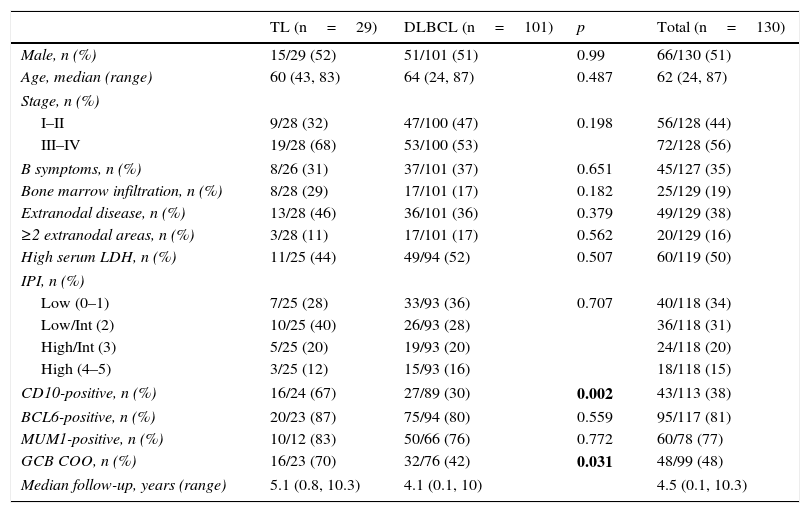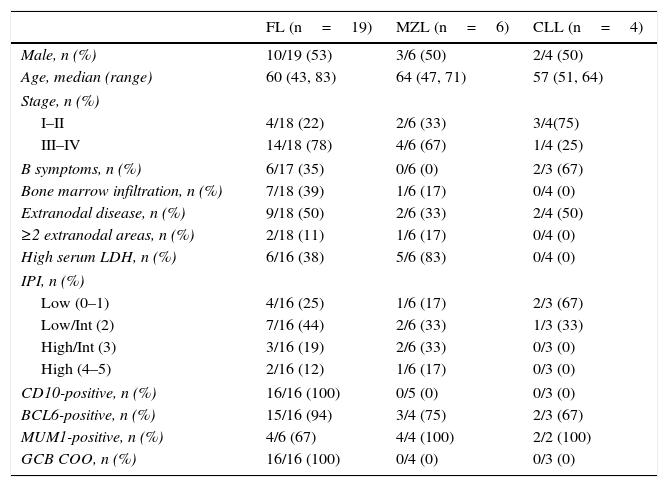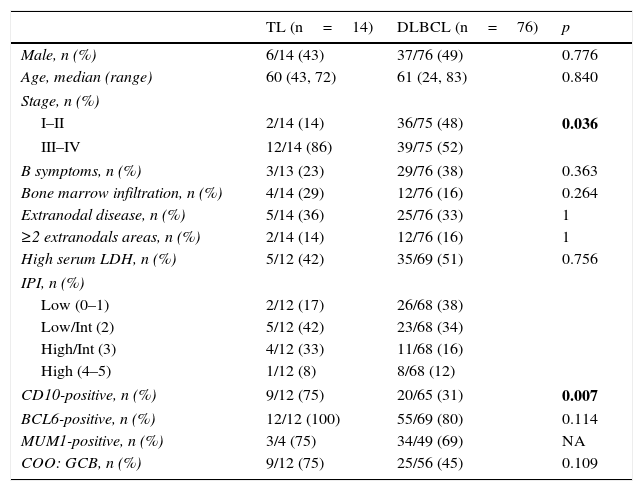The prognosis of diffuse large B-cell lymphomas (DLBCL) transformed from indolent lymphoma (TL) has been considered poorer than that of de novo DLBCL. However, it seems to have improved since the introduction of rituximab.
Patients and methodsWe compared the characteristics (including the cell-of-origin), and the prognosis of 29 patients with TL and 101 with de novo DLBCL treated with immunochemotherapy.
ResultsPatients with TL and de novo DLBCL had similar characteristics. All TL cases evolving from follicular lymphoma were germinal-center B-cell-like, while those TL from marginal zone lymphoma or chronic lymphocytic leukemia were non-germinal-center B-cell-like. The complete response rate was similar in TL and de novo DLBCL (62 vs. 66%, p=0.825). The 5-year overall and progression-free survival probabilities (95% CI) were 59% (40–78) and 41% (22–60) for TL and 63% (53–73) and 60% (50–70) for de novo DLBCL, respectively (p=0.732 for overall survival and p=0.169 for progression-free survival).
ConclusionIn this study, the prognosis of TL and de novo DLBCL treated with immunochemotherapy was similar. The role of intensification with stem cell transplantation in the management of TL may be questionable in the rituximab era.
El pronóstico de los linfomas difusos de células B grandes (LDCBG) transformados de linfomas indolentes (LT) ha sido considerado más desfavorable que el pronóstico de LDCBG de novo. Sin embargo, este parece haber mejorado desde la introducción de rituximab.
Pacientes y métodosSe compararon las características (incluyendo la célula de origen) y el pronóstico de 29 pacientes con LT y 101 con LDCBG de novo tratados con inmunoquimioterapia.
ResultadosLos pacientes con LT y LDCBG de novo tenían características similares. Todos los casos de LT que evolucionaron de un linfoma folicular fueron linfomas de células B de tipo centro germinal, mientras que aquellos LT que evolucionaron de un linfoma de la zona marginal o leucemia linfocítica crónica fueron de tipo no centro germinal. El índice de respuesta completa fue similar en los LT y en los LDCBG de novo (62 frente a 66%, p=0,825). Las probabilidades de supervivencia global y libre de progresión a 5 años (IC 95%) fueron del 59% (40–78) y el 41% (22–60) para LT y del 63% (53–73) y el 60% (50–70) para LDCBG de novo, respectivamente (p=0,732 para supervivencia global y p=0,169 para supervivencia libre de progresión).
ConclusiónEn este estudio, el pronóstico de los LT y LDCBG de novo tratados con inmunoquimioterapia fue similar. El papel de la intensificación con trasplante de precursores hematopoyéticos en el tratamiento del LT puede ser cuestionable en la era del rituximab.
Artículo
Comprando el artículo el PDF del mismo podrá ser descargado
Precio 19,34 €
Comprar ahora












